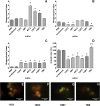Monoclonal antibodies to heat shock protein 60 alter the pathogenesis of Histoplasma capsulatum
- PMID: 19179416
- PMCID: PMC2663142
- DOI: 10.1128/IAI.01443-08
Monoclonal antibodies to heat shock protein 60 alter the pathogenesis of Histoplasma capsulatum
Abstract
Heat shock proteins with molecular masses of approximately 60 kDa (Hsp60) are widely distributed in nature and are highly conserved immunogenic molecules that can function as molecular chaperones and enhance cellular survival under physiological stress conditions. The fungus Histoplasma capsulatum displays an Hsp60 on its cell surface that is a key target of the cellular immune response during histoplasmosis, and immunization with this protein is protective. However, the role of humoral responses to Hsp60 has not been fully elucidated. We generated immunoglobulin G (IgG) isotype monoclonal antibodies (MAbs) to H. capsulatum Hsp60. IgG1 and IgG2a MAbs significantly prolonged the survival of mice infected with H. capsulatum. An IgG2b MAb was not protective. The protective MAbs reduced intracellular fungal survival and increased phagolysosomal fusion of macrophages in vitro. Histological examination of infected mice showed that protective MAbs reduced the fungal burden and organ damage. Organs of infected animals treated with protective MAbs had significantly increased levels of interleukin-2 (IL-2), IL-12, and tumor necrosis factor alpha and decreased levels of IL-4 and IL-10. Hence, IgG1 and IgG2a MAbs to Hsp60 can modify H. capsulatum pathogenesis in part by altering the intracellular fate of the fungus and inducing the production of Th1-associated cytokines.
Figures





References
-
- Ajello, L. 1971. Coccidioidomycosis and histoplasmosis. A review of their epidemiology and geographical distribution. Mycopathol. Mycol. Appl. 45221-230. - PubMed
-
- Albuquerque, P. C., E. S. Nakayasu, M. L. Rodrigues, S. Frases, A. Casadevall, R. M. Zancope-Oliveira, I. C. Almeida, and J. D. Nosanchuk. 2008. Vesicular transport in Histoplasma capsulatum: an effective mechanism for trans-cell wall transfer of proteins and lipids in ascomycetes. Cell. Microbiol. 101695-1710. - PMC - PubMed
-
- Allen, H. L., and G. S. Deepe, Jr. 2006. B cells and CD4−CD8− T cells are key regulators of the severity of reactivation histoplasmosis. J. Immunol. 1771763-1771. - PubMed
-
- Allendoerfer, R., G. P. Biovin, and G. S. Deepe, Jr. 1997. Modulation of immune responses in murine pulmonary histoplasmosis. J. Infect. Dis. 175905-914. - PubMed
-
- Allendorfer, R., G. D. Brunner, and G. S. Deepe, Jr. 1999. Complex requirements for nascent and memory immunity in pulmonary histoplasmosis. J. Immunol. 1627389-7396. - PubMed
Publication types
MeSH terms
Substances
Grants and funding
LinkOut - more resources
Full Text Sources
Other Literature Sources
Research Materials
Miscellaneous

